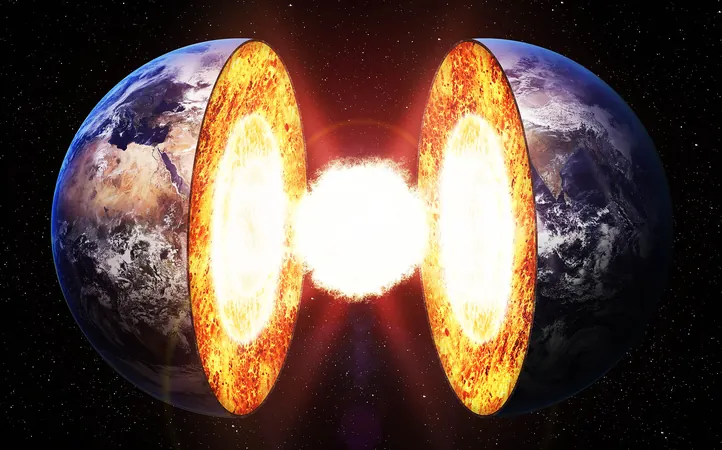
Revolutionary Findings Unveil the Hidden Connections of Earth’s Volcanic Hotspots
2024-09-23
When we think of dramatic volcanic eruptions and rivers of molten lava, our imagination often conjures the notion of Earth’s mantle as an enigmatic source powering these fiery phenomena. Volcanic hotspots, from the lush landscapes of Hawaii to the rugged terrains of Iceland, have long been thought to be unique, shaped by their particular geological circumstances. However, groundbreaking research published in *Nature Geoscience* suggests that our understanding of these processes might be fundamentally flawed.
The Groundbreaking Revelation: A Shared Origin of Hotspot Lavas
Recent studies led by Dr. Matthijs Smit, an associate professor and Canada Research Chair at the University of British Columbia, indicate that despite the apparent diversity of volcanic lavas, they may actually stem from a surprisingly uniform reservoir deep within the Earth's mantle. This astonishing finding challenges longtime beliefs that the mantle comprises disparate and isolated chemical reservoirs.
“The discovery literally turns our view of hotspot lavas and the mantle upside down,” Dr. Smit emphasized. He likens Earth’s diverse lavas to humanity — all originating from a common ancestor, yet evolving into unique forms dictated by their environment.
Explaining the Taste of Lava: Unique Journey or Shared Foundation?
How, then, do lavas from different hotspots possess such distinct chemical signatures? Researchers propose that as magma ascends through the Earth's crust, it interacts with various surrounding rocks, resulting in unique compositions by the time it erupts. “By examining specific elemental patterns, we unraveled that these lavas share a foundational chemical makeup, altering only through their journey,” Dr. Smit explained.
The Challenges in Studying the Mantle
Understanding Earth’s mantle, the semi-solid layer beneath the crust, is notoriously challenging. Direct sampling is impossible; scientists rely on trace-element and isotope analysis of erupted lavas. This methodology previously reinforced the idea that the mantle housed diverse reservoirs, but Dr. Smit's research indicates a more homogeneous nature.
“This shifts how we view Earth’s chemical evolution and global element cycling,” he added. The research suggests that the mantle likely no longer contains the “primordial reservoirs” previously posited to explain its complexities.
Implications Beyond Geology: A Broader Perspective
This revelation necessitates a reevaluation of existing geological models and theories regarding lava diversity and the mantle's structure. Traditionally, scientists believed variations in eruptive lava hinted at a mixed composition conceptualized as a heterogeneous mantle. The new framework points to the idea that volcanic diversity arises during magma ascent, reshaping assumptions about mantle convection and plate tectonics.
These findings are not limited to academic theory; they carry significant implications for natural disaster preparedness. By enhancing models concerning volcanic activity, scientists can better predict eruptions, potentially safeguarding populations residing near these geological hotspots.
The Global Collaboration Radiation
Moreover, the discovery of a uniform mantle could shape environmental policy. It highlights the need for international research collaboration to advance our understanding of volcanic processes, which can inform policies related to disaster preparedness.
As climate change poses increasing challenges, refining our grasp of Earth’s internal dynamics is crucial. The knowledge gained about the mantle's chemistry can inform strategies to mitigate the impacts of natural disasters on communities worldwide.
A New Era for Tectonics and Volcano Research
This newfound perspective on a chemically homogeneous mantle not only redefines volcanic studies but also has profound implications for plate tectonics. Where once scientists believed distinct reservoirs drove tectonic plate movements, this insight fosters a notion of increased global interconnectivity.
Understanding how mantle material circulates could illuminate the relationships between mantle chemical interactions, volcanic activity, and tectonic shifts. As researchers continue this exploration, there may be groundbreaking advances in predicting volcanic behavior, especially in seismic hotspots like the Pacific Ring of Fire.
Overall, the full implications of this study are still unfolding, but it is clear that we are on the cusp of a new understanding of Earth’s inner workings. The future of geological science has never looked more promising, and we stand to learn much more about our planet’s fiery heart than we ever anticipated.
For those intrigued by these transformative discoveries, the full study can be found in the journal *Nature Geoscience*.


 Brasil (PT)
Brasil (PT)
 Canada (EN)
Canada (EN)
 Chile (ES)
Chile (ES)
 España (ES)
España (ES)
 France (FR)
France (FR)
 Hong Kong (EN)
Hong Kong (EN)
 Italia (IT)
Italia (IT)
 日本 (JA)
日本 (JA)
 Magyarország (HU)
Magyarország (HU)
 Norge (NO)
Norge (NO)
 Polska (PL)
Polska (PL)
 Schweiz (DE)
Schweiz (DE)
 Singapore (EN)
Singapore (EN)
 Sverige (SV)
Sverige (SV)
 Suomi (FI)
Suomi (FI)
 Türkiye (TR)
Türkiye (TR)